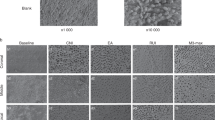Summary
Calcium hydroxide (CH) is applied to improve disinfection of root canals in most root canal retreatment. This study aimed to analyze the CH removal efficacy using 7 different root preparing files (K file, pre-curved K file, EndoActivator, Ultrasonic file, pre-curved ultrasonic file, F file and needle irrigation alone) with apical transportation. Standardized models of curved canal with such apical transportation or not were set up before applying CH to root canal for 7 days. Seven techniques described above were used for its removal. Then the roots were disassembled and digital photos were taken. The ratio of residual CH in the overall canal surface was calculated using the image analyzer image pro plus 6.0. The data were analyzed using one-way ANOVA with post hoc Tukey test. Results revealed that CH was effectively removed (P<0.05) by using all 6 mechanical methods except irrigation alone. In curved root canals with apical transportation, EndoActivator, pre-curved ultrasonic file and F file were found to be more effective in removing CH than the other four file (P<0.001), while there was no significant difference among EndoActivator, pre-curved ultrasonic file and F file groups (P>0.05). The percentage of residual CH in the canal with apical transportation was higher than that in the canal without apical transportation (P<0.05). In conclusion, CH can be hardly removed completely. Canal with apical transportation will result in insufficient CH removal. EndoActivator, pre-curved ultrasonic file and F file are more effective in the curved root canal with apical transportation.
Similar content being viewed by others
References
Trope M, Delano EO, Ørstavik D. Endodontic treatment of teeth with apical periodontitis: single vs. multivisit treatment. J Endod, 1999,25(5):345–350
Javidi M, Zarei M, Afkhami F, et al. An in vitro evaluation of environmental pH changes after root canal therapy with three different types of calcium hydroxide. Eur J Dent, 2013,7(1):69–73
Athanassiadis B, Abbott PV, Walsh LJ. The use of calcium hydroxide, antibiotics and biocides as antimicrobial medicaments in endodontics. Aus Dent J, 2007,52(s1): S64–S82
Kim SK, Kim YO. Influence of calcium hydroxide intracanal medication on apical seal. Int Endod J, 2002,35(7): 623–628
Barbizam JV, Trope M, Teixeira EC, et al. Effect of calcium hydroxide intracanal dressing on the bond strength of a resin-based endodontic sealer. Braz Dent J, 2008,19(3):224–227
Zmener O, Pamejer CH, Bangegas G. Effectiveness in cleaning oval-shaped root canals using anatomic endodontic technology, ProFile and manual instrumentation: a scanning electron microscopic study. Int Endod J, 2005,38(6):356–363
Siqueira JF. Aetiology of root canal treatment failure: why well-treated teeth can fail. Int Endod J, 2001,34(1):1–10
Card SJ, Sigurdsson A, Ørstavik D, et al. The effectiveness of increased apical enlargement in reducing intracanal bacteria. J Endod, 2002,28(11):779–783
Kuga MC, Tanomaru-Filho M, Faria G, et al. Calcium hydroxide intracanal dressing removal with different rotary instruments and irrigating solutions: a scanning electron microscopy study. Braz Dent J, 2010,21(4):310–314
Kvist T, Molander A, Dahlén G, et al. Microbiological evaluation of one- and two-visit endodontic treatment of teeth with apical periodontitis: a randomized, clinical trial. J Endod, 2004,30(8):572–576
Field JW, Gutmann JL, Solomon ES, et al. A clinical radiographic retrospective assessment of the success rate of single-visit root canal treatment. Int Endod J, 2004,37(1): 70–82
Steven LK, Timothy CK, Richard ER. In vitro comparisons of debris removal of the EndoActivatorTMsystem, the F fileTM, Ultrosonic irrigation and NaOCl irrigation alone after hand-rotary instrumentation in human mandibular molars. J Endod, 2010,36(8):1367–1371
Tasdemir T, Celik D, Yildirim KET, et al. Efficacy of several techniques for the removal on calcium hydroxide medicament from root canals. Int Endod J, 2011,44(6): 505–509
Khaleel HY, Al-Ashaw AJ, Yang Y, et al. Quantitative comparison of calcium hydroxide removal by EndoActivator, Ultrasonic and ProTaper File agitation techniques: An in vitro study. J Huazhong Univ Sci Technol Med Sci, 2013,33(1):142–145
Wiseman A, Cox TC, Paranjpe A, et al. Efficacy of sonic and ultrasonic activation for removal of calcium hydroxide from mesial canals of mandibular molars: A mocrotomographic study. J Endod, 2010,37(2):235–238
Ceci NC, Jose B, Patricia HP, et al. Effect of calcium hydroxide intracanal dressing on the bond strength of two endodontic resin-based sealer assessed by micropush-out test. Den Traumatol, 2013,29(1):73–76
Lucas S, Min-Kai W, Paul W, et al. Comparison of 2 flushing methods used during passive ultrasonic irrigation of the root canal. Quintessence Int, 2009,40(10): 875–879
Edgar S, Till D. Development and sequelae of canal transportation. Endod Topics, 2009,15:75–90
American Association of Endodontists. Glossary of endodontic terms. 7th ed. Chicago: AAE, 2003.
Kenee DM, Allemang JD, Johnson JD, et al. A quantitative assessment of efficacy of various calcium hydroxide removal techniques. Int Endod J, 2006,32(6):563–565
Van der Sluis LWM, Wu MK, Wesselink PR. The evaluation of removal of calcium hydroxide paste from an artificial standardized groove in the apical root canal using different irrigation methodologies. Int Endod J, 2007,40(1):52–57
Lei-Meng J, Bram V, Michel V, et al. Evaluation of a sonic device designed to activate irrigant in the root canal. J Endod, 2010,36(1):143–146
Author information
Authors and Affiliations
Corresponding author
Additional information
The authors contributed equally to this work.
This project was supported by the National Natural Science Foundation of China (No. 81200781).
Rights and permissions
About this article
Cite this article
Song, Y., Ma, Jz., Wang, Ry. et al. Calcium hydroxide removal in curved root canals with apical transportation In Vitro . J. Huazhong Univ. Sci. Technol. [Med. Sci.] 34, 608–611 (2014). https://doi.org/10.1007/s11596-014-1324-y
Received:
Revised:
Published:
Issue Date:
DOI: https://doi.org/10.1007/s11596-014-1324-y




